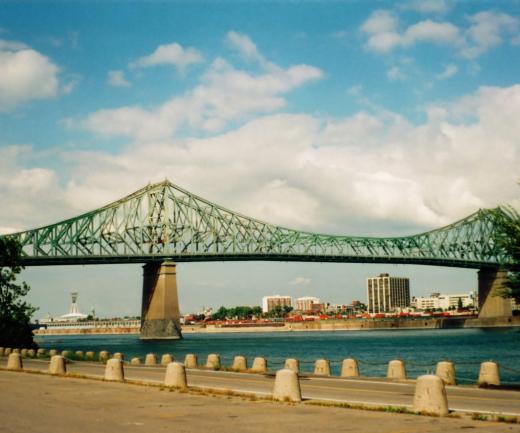What Is a Truss Bridge?
The truss bridge is one of the oldest and strongest types of bridges. The basic truss design consists of three basic components: the piers, the chords and the diagonal "webs" that give the truss its distinctive, triangular-webbed appearance. More elaborate truss bridges may also sport struts, sway bracing and wind bracing.
At first glance, a truss bridge appears to be a conglomeration of triangles connected together in a streamlined mass. These triangles do shape the support structure of the truss design, but the foundation of the truss bridge consists of two or more straight, horizontal beams, called "chords." Smaller beams called "webs" connect the larger beams at diagonal angles, giving the appearance of triangles fitted together in an enormous jigsaw puzzle. Piers form the bridge "legs" to hold it up off the ground or water.

Truss engineering is a marvel of bridge technology, with some very old bridges still in excellent working condition. The triangular webs between the long horizontal chords prevent the chords from flexing or bending. Unlike the arch bridge, the truss bridge does not support the bridge from below the roadway. Different from the suspension bridge, the truss does not support the bridge from above the roadway. The truss bridge supports the structure itself, using tension and compression to draw the individual members closer into a tight, solid, stiff structure.
The earliest and simplest type of truss bridge is the king post truss. Two beams tilt toward each other to form a triangle. A long parallel tie beam, or chord, forms the base of the triangle. Hanging down from the apex of the triangle to the chord is a strong tension rod. This type of truss is still used today for short bridges and modern home construction and is best suited for spans of 35 feet (10.67 meters) or less.
The queen post truss is a more elaborate adaptation of the king post, featuring a small square inside the large triangle. Additional webs form a tighter and stiffer structure, able to bear heavier loads and longer spans of up to 70 feet (21.3 meters). In 1840, engineer William Howe developed his Howe truss design, which connected multiple diagonal webs to two parallel chords. The Howe truss load can handle spans of 150 feet (45.72 meters). Modern engineers have constructed numerous variations of the truss bridge able to handle even longer spans.
Examples of truss bridges abound throughout the world. The New Fork River Bridge in Sublette County, Wyoming, is a fine example of the king post truss. In Thailand, the Bridge over the River Kwai, constructed by World War II prisoners and popularized by the movie of the same name, is a steel truss bridge. A stunning truss arch bridge called the Navajo Bridge is located in Lees Ferry, Arizona. Scotland's Firth of Forth bridge, completed in 1890 and spanning 350 feet (106.68 meters) is an example of a cantilever truss, and China's Garden Bridge in Shanghai sports a unique camelback truss.
AS FEATURED ON:
AS FEATURED ON:











Discuss this Article
Post your comments